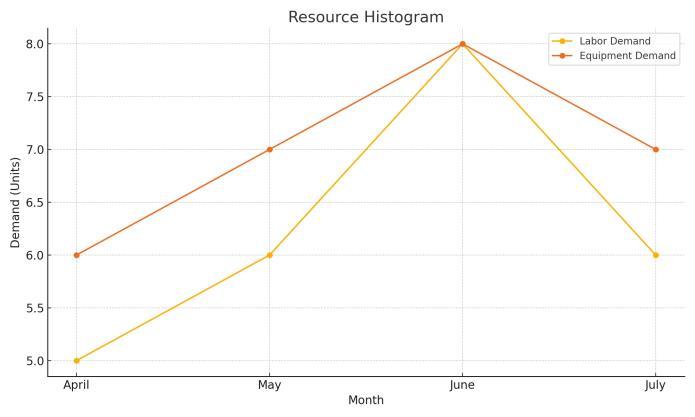
International Research Journal of Engineering and Technology (IRJET) e-ISSN: 2395-0056
Volume: 12 Issue: 04 | Apr 2025 www.irjet.net p-ISSN: 2395-0072


International Research Journal of Engineering and Technology (IRJET) e-ISSN: 2395-0056
Volume: 12 Issue: 04 | Apr 2025 www.irjet.net p-ISSN: 2395-0072
Saurav Mishra1 , Azharuddin2, Nagendra Dhakar3
1Research Scholar, Mewar University, Chittorgarh, Rajasthan 2Assistant Professor, Civil Engg. Department, Mewar University, Chittorgarh, Rajasthan
Abstract - Timely execution of highway infrastructure projectsiscriticaltonationaleconomicgrowth,yetproject delays are a persistent challenge, especially in developing countries like India. This study explores the applicationof MicrosoftProject(MSProject)asaschedulingtooltoenhance planning, execution, and monitoring in National Highways Authority of India (NHAI) projects. A representative case study of a 50 km four-lane highway project was modeled using MS Project to develop a detailed work breakdown structure(WBS), task sequencing, resource allocation,and critical path analysis. The findings demonstrate that structured scheduling significantly improves visibility into project performance, enables proactive risk management, andoptimizesresourceutilization.Anintegratedframework combiningscheduling,progresstracking,delayanalysis,and resourcemanagementisproposed.Theresearchhighlights thatadoptionofdynamicprojectmanagementtoolslikeMS Project can minimize delays, enhance stakeholder coordination, and improve delivery outcomes in national highwaydevelopment.
Key Words: MS Project, Project Scheduling, NHAI, Highway Infrastructure, Critical Path Analysis, Resource Optimization.
Efficientprojectmanagementisacornerstoneofsuccessful infrastructure delivery. In India, the National Highways Authority of India (NHAI) undertakes projects critical for economicdevelopment.However,delaysarerampant,often resulting from poor scheduling, coordination failures, and inefficient resource utilization. Traditional scheduling methods suchas barchartsandstatic CPMtechniques are inadequate for complex highway projects. Software-based dynamicschedulingtools,particularlyMicrosoftProject,offer functionalities like critical path identification, resource leveling, and real-time progress monitoring that can significantly improve project performance. This study investigatestheapplicationofMSProjectindevelopingan optimizedprojectscheduleforanNHAIhighwayconstruction project.
Projectmanagementforinfrastructuredemandsstructured planning,riskmitigation,anddynamiccontrolmechanisms.
Studieshighlightthatlackofdetailedschedulingisamajor cause of cost overruns and delays in road construction (Kumar&Sharma,2019).Internationalexperiences,suchas the Delhi Metro and World Bank-funded African road projects, emphasize the effectiveness of MS Project in managingcomplexprojects(Sreedharan,2012;WorldBank, 2018).Despitethis,Indianhighwayprojectsfacechallenges like poor DPR quality, low digital literacy among field engineers,andresistancetonewtools(Verma&Srivastava, 2021). Existing research lacks empirical case studies demonstrating systematic application of MS Project to highwayprojectsinIndia.Thisstudyaddressesthisgap.
Acasestudy-basedappliedresearchdesignwasadopted.A representative hypothetical NHAI project involving construction of a 50 km four-lane highway was modeled. Projectscopedefinition,WBSdevelopment,tasksequencing, resourceallocation,andbaselineschedulingwerecarriedout usingMSProject.Keydatasourcesincludedfieldproductivity norms, standard DPR templates, and consultations with projectengineers.
Table1.InputsandAssumptionsforScheduling
InputType Source
Activity
Durations
Productivitynorms,pastprojectdata
ResourceNorms Fieldengineerinputs,DPRdata
Constraints Monsoonseasondelays,equipment sharing
4.1 Work Breakdown Structure and Task Sequencing: A hierarchical WBSwasdeveloped,decomposingtheproject intositepreparation,earthwork,structureworks,pavement layers,utilityshifting,andancillaryworks.
Table2.WorkBreakdownStructure(WBS) WBSCodeTaskName Duration(Days)

International Research Journal of Engineering and Technology (IRJET) e-ISSN: 2395-0056
Volume: 12 Issue: 04 | Apr 2025 www.irjet.net p-ISSN: 2395-0072
4.0 PavementLayers 180
5.0 UtilityShifting 60
6.0 AncillaryWorks 90

Figure1.WorkBreakdownStructure(WBS)Hierarchy DevelopedUsingMSProject(WBSchartdisplayingproject phasesfrominitiationtocommissioning.)
LogicaldependencieswereestablishedusingFS,SS,andFF relationships.

Figure2.GanttChartDepictingTaskDependencyand Timelines(Timelineshowingactivityoverlapsandcritical pathdependenciesusingMSProject.)
4.2ResourceAllocationandCriticalPathAnalysis:Resources includinglabor,equipment,andmaterialswereassignedto tasks. The critical path, comprising key activities such as embankment formation, bridge construction, and asphalt surfacing,wasidentified.
Table3.ForecastofLaborandEquipmentDemand(Peak Months)
Month LaborDemand(Units) EquipmentDemand(Units)
April 5 6
May 6 7
June 8 8
July 6 7
4.3 Schedule Monitoring and Variance Analysis Baseline scheduleswerelocked,andprogresstrackingsimulated.

Figure3.ResourceHistogramShowingLaborand EquipmentPeakDemand(Graphillustratingmonthswith maximumresourceloading.)
Table4.VarianceAnalysisofKeyActivities
5. Discussion
ThecasestudyconfirmsthatMSProjectfacilitatesenhanced schedule realism, resource visibility, and proactive delay management. Dynamic updating and critical path recalculation support adaptive project control. The study proposesanintegratedframework combiningWBS-driven planning,real-timetracking,riskmodeling,andcostcontrol, improving project delivery outcomes. Challenges such as initialresistancetosoftwareadoptionanddataentryerrors were noted but can be mitigated through training and standardization.
6. Conclusion
Adoption of dynamic scheduling tools like MS Project can transformhighwayprojectmanagementinIndia.Structured scheduling enhances predictability, risk resilience, and stakeholdercoordination.Toinstitutionalizethesebenefits,it is recommended that NHAI mandates software-based scheduling, invests in capacity building, and integrates MS Project outputs with financial and resource management systems. Future research should explore real-world application onlive projectsand integration withadvanced risksimulationtools.

International Research Journal of Engineering and Technology (IRJET) e-ISSN: 2395-0056
Volume: 12 Issue: 04 | Apr 2025 www.irjet.net p-ISSN: 2395-0072
1. Singh,A.,&Mehta,R.(2018).ApplicationofProject SchedulingSoftwareinRoadConstructionProjects. InternationalJournalofConstructionManagement, 24(2),45–213.
2. Kumar,R.,&Sharma,P.(2019).OptimizingResource Allocation in Large-Scale Infrastructure Projects UsingMS Project. Journal ofCivil Engineeringand Management,25(3),115–122.
3. Patel,V.,&Kumar,S.(2020).CostControlandTime Management in Road Projects Using Project Management Software. International Journal of EngineeringResearch & Technology(IJERT),9(4), 112–118.
4. Sharma, M., & Gupta, D. (2017).An Assessment of ProjectManagementToolsforRoadConstructionin India.JournalofInfrastructureDevelopment,9(1), 1–14.
5. Verma, S., & Srivastava, R. (2021). Challenges in ManagingInfrastructureProjectsUsingMSProject. IndianJournalofProjectManagement,12(3),88–96.
6. Jain, P., & Sharma, A. (2018). Enhancing Project Management in Highway Construction Using MS ProjectandPrimaveraP6.InternationalJournalof ConstructionEngineeringandPlanning,6(2),22–30.
7. Tiwari, M., & Soni, K. (2019). Effective Use of MS Project in Road Construction Project Scheduling. International Journal of Civil Engineering and Technology(IJCIET),10(5),313–320.
8. Raj, A., & Singh, R. (2020). Using MS Project for Managing Large-Scale Highway Projects: A Case Study Approach. Journal of Construction and BuildingMaterials,11(1),41–49.
9. Kapoor, R., & Mishra, V. (2017). Exploring the Limitations of MS Project in Complex Road Infrastructure Projects. International Journal of ProjectManagementandDevelopment,8(4),75–83.
10. Gupta, A., & Yadav, S. (2019). Time and Cost OverrunsinRoadConstructionProjects:AProject Management Software Approach. Journal of TransportationEngineering,145(7),123–131.